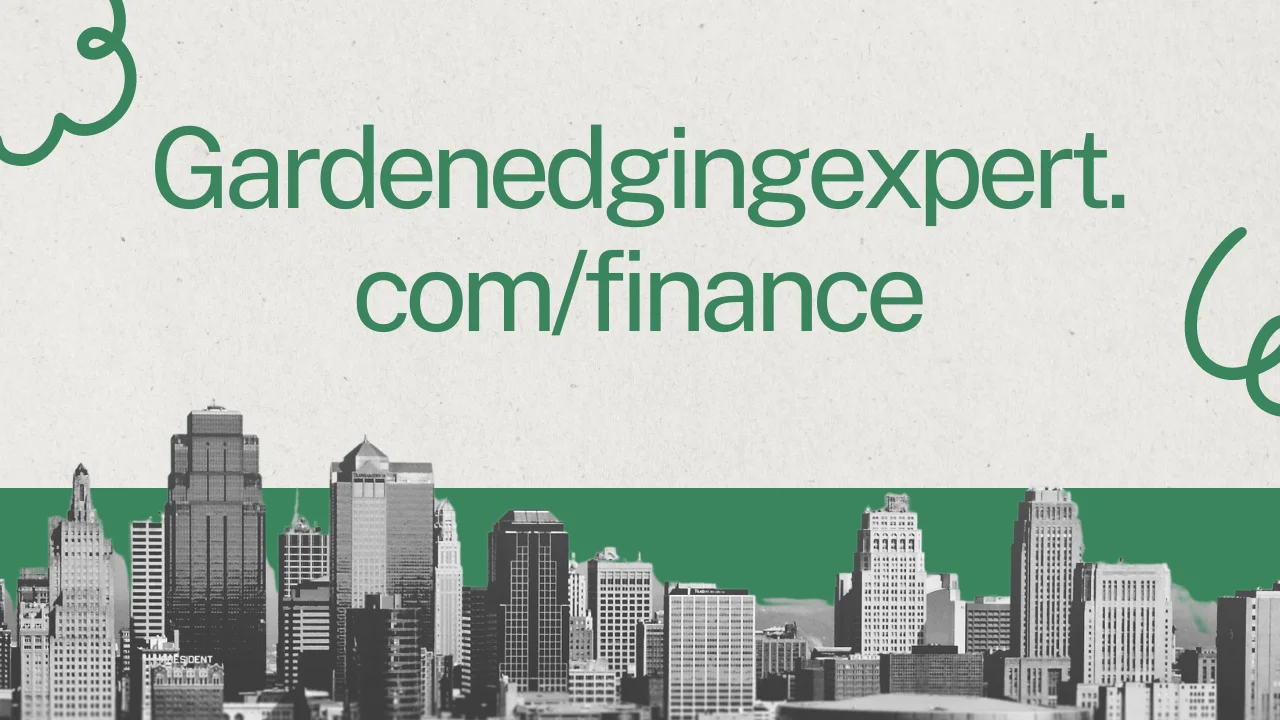Gardening is a rewarding endeavor, transforming outdoor spaces into beautiful and functional areas. Garden edging, a crucial element in garden design, not only enhances the aesthetic appeal but also contributes to the overall organization and maintenance of the garden. However, like any home improvement project, garden edging requires careful financial planning. This guide, inspired by gardenedgingexpert.com/finance, delves into the financial aspects of garden edging projects, offering insights into costs, budgeting strategies, financing options, and potential returns on investment.
Understanding Garden Edging Expenses
Embarking on a garden edging project involves various expenses that need thorough consideration to avoid unexpected costs. Here, we break down the primary expenses associated with garden edging.
Material Expenses
Types of Materials
The choice of materials significantly impacts the cost of garden edging. Common materials include natural stones, recycled plastics, metal, and concrete. Each material has its price range and durability, influencing the overall budget.
Cost Variations
Material costs can vary widely based on quality and availability. For instance, natural stones might be more expensive but offer a timeless look, whereas recycled plastics are cost-effective and eco-friendly.
Sourcing and Transportation
The source of materials and transportation costs can add to the expenses. Locally sourced materials might be cheaper, while imported options could drive up the costs due to shipping fees.
Labor Costs
Hiring Professionals
Professional installation ensures high-quality results but comes with higher labor costs. Experienced landscapers charge for their expertise, which can significantly increase the project’s budget.
DIY Approach
Opting for a DIY approach can save on labor costs but requires time, effort, and some level of skill. It’s crucial to weigh the pros and cons of DIY versus professional services to make an informed decision.
Maintenance Costs
Routine Maintenance
Garden edging requires regular maintenance to preserve its appearance and functionality. Routine tasks include cleaning, weeding, and minor repairs, which incur ongoing costs.
Long-Term Upkeep
Some materials, like metal or wood, may need periodic treatments or replacements over time. Understanding the long-term upkeep costs is essential for accurate budgeting.
Creating a Realistic Budget
A realistic budget is the backbone of any successful garden edging project. It ensures that you stay within your financial limits while achieving your desired garden design.
Assessing Your Financial Situation
Personal Savings
Utilizing personal savings can be a straightforward way to finance your garden edging project. It avoids the complexities of loans or credit but requires a solid savings plan.
Loans and Credit Options
Secured Loans
Secured loans, backed by collateral like property, often offer lower interest rates. They can provide the necessary funds for large projects but come with the risk of losing the collateral if repayments are not made.
Unsecured Loans
Unsecured loans, such as personal loans, do not require collateral but usually have higher interest rates. They are suitable for smaller projects or when collateral is not an option.
Credit Cards
Using credit cards can be convenient for smaller purchases, but high-interest rates can make this an expensive option if not managed carefully.
Government Grants and Subsidies
In some regions, government grants or subsidies may be available for landscaping projects, especially those promoting eco-friendly practices. Researching local programs can provide additional financial support.
Weighing DIY vs Professional Services
Deciding between a DIY project and hiring professionals is crucial for your budget and the project’s success.
Pros and Cons of DIY
Cost Savings
DIY projects can significantly reduce labor costs. However, they require time, effort, and a certain level of expertise.
Skill Requirements
Successful DIY garden edging demands various skills, from basic landscaping to more advanced construction techniques. Assessing your skills honestly can prevent costly mistakes.
Hiring Professionals
Quality Assurance
Professional services ensure high-quality results, often with a warranty or guarantee. This can be particularly valuable for complex or large-scale projects.
Time Efficiency
Hiring professionals saves time, allowing you to enjoy your garden sooner. Professionals also handle unexpected issues more efficiently.
Financing Application Process
Understanding the financing application process is crucial for securing the necessary funds for your garden edging project.
Improving Credit Scores
Credit History
A good credit history improves your chances of securing loans at favorable interest rates. Regularly checking and managing your credit score is essential.
Paying Off Debts
Reducing existing debts before applying for new financing can improve your credit score and loan terms.
Navigating the Application
Documentation
Gathering all necessary documentation, including proof of income, credit history, and project estimates, can streamline the application process.
Choosing the Right Lender
Comparing different lenders and their terms ensures you get the best deal. Consider banks, credit unions, and online lenders for various options.
Potential Return on Investment (ROI)
Investing in garden edging can offer significant returns, both financially and aesthetically.
Enhancing Property Value
Well-designed garden edging can increase the overall value of your property. It improves curb appeal, making your home more attractive to potential buyers.
Curb Appeal
Garden edging adds a polished, finished look to your garden, enhancing its overall appeal and making a positive first impression.
Long-Term Maintenance Savings
High-quality garden edging materials can reduce long-term maintenance costs. Durable materials require less frequent replacement or repair, saving money over time.
Tax Implications
Understanding the tax implications of your garden edging project can help you make informed financial decisions.
Deductible Expenses
In some cases, home improvement projects that add value to your property can be tax-deductible. Consult a tax advisor to understand the potential benefits.
Eco-Friendly Materials
Using eco-friendly materials for garden edging can offer environmental benefits and potential financial incentives.
Recycled Plastic
Recycled plastic edging is cost-effective, durable, and environmentally friendly. It reduces waste and can sometimes qualify for green building incentives.
Natural Stones
Natural stones are a sustainable option that blends seamlessly with the environment. They are durable and require minimal maintenance, offering long-term savings.
Future Trends in Garden Edging
Staying ahead of future trends can enhance the functionality and appeal of your garden edging project.
Smart Technology
Integrating smart technology, such as automated watering systems and lighting, can increase the efficiency and convenience of your garden.
Modular Designs
Modular designs offer flexibility and ease of installation. They can be customized to fit various garden layouts and easily reconfigured as needed.
Sustainable Practices
Adopting sustainable practices, such as using locally sourced materials and promoting biodiversity, can enhance the environmental benefits of your garden edging project.
Investing Wisely
Making informed decisions and investing wisely in garden edging ensures long-term satisfaction and financial benefits.
Balancing Aesthetics and Finances
Striking a balance between aesthetic appeal and financial feasibility is crucial. Prioritize essential features and consider phased installations to manage costs effectively.
FAQs
What are the costs involved in garden edging projects?
Garden edging projects involve costs for materials, labor, and maintenance. Material costs vary based on the type and quality, while labor costs depend on whether you hire professionals or opt for a DIY approach. Maintenance costs include routine upkeep and long-term repairs.
How to budget for a garden edging project?
Budgeting for a garden edging project involves assessing your financial situation, estimating costs, and exploring financing options. Consider personal savings, loans, credit options, and potential government grants. Creating a detailed budget helps ensure you stay within your financial limits.
What are the best financing options for garden edging?
Financing options for garden edging include personal savings, secured and unsecured loans, credit cards, and government grants. Each option has its advantages and considerations, such as interest rates, repayment terms, and eligibility requirements.
How to estimate garden edging material expenses?
Estimating material expenses involves choosing the type of materials, understanding cost variations, and considering sourcing and transportation costs. Researching local suppliers and comparing prices can help you make informed decisions and manage your budget effectively.
Should I DIY my garden edging or hire a professional?
Deciding between DIY and hiring professionals depends on your budget, skills, and project complexity. DIY can save on labor costs but requires time and expertise. Hiring professionals ensures high-quality results and time efficiency but comes with higher labor costs.
Also Read: Empowering Digital Expression in a World of Conformity BaddieHubb
Conclusion
Garden edging projects, when carefully planned and executed, can significantly enhance the beauty and functionality of your outdoor space. By understanding the financial aspects, including costs, budgeting, financing options, and potential returns on investment, you can make informed decisions that balance aesthetics with financial feasibility. Gardenedgingexpert.com/finance serves as a comprehensive resource to guide you through every step of this journey, ensuring your garden edging project is both beautiful and financially sound.



